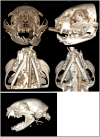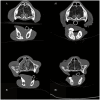Clinical outcomes of mandibular body fracture management using wire-reinforced intraoral composite splints in 15 cats
- PMID: 40196811
- PMCID: PMC11973384
- DOI: 10.3389/fvets.2025.1552682
Clinical outcomes of mandibular body fracture management using wire-reinforced intraoral composite splints in 15 cats
Abstract
The study assesses the use of wire-reinforced intraoral composite splints (WRICS) for stabilising mandibular body fractures in feline patients. It reviews 15 cases treated at a referral centre, focusing on the effectiveness of WRICS in achieving stable fracture repair, occlusion, and patient comfort. The fractures were most commonly between the canine tooth and third premolar (73%). Results indicate that WRICS can provide effective stabilisation with a median healing time of 8 weeks. Normocclusion was achieved in 14 out of 15 cases. Major complications were found in two cases (13%) and were associated with soft tissue ulceration. This study supports WRICS as a minimally invasive, reliable approach to mandibular body fracture stabilisation in cats.
Keywords: composite; fracture; mandibular body; minimally invasive; occlusion; splint; wire.
Copyright © 2025 Pakula, Freeman and Perry.
Conflict of interest statement
The authors declare that the research was conducted in the absence of any commercial or financial relationships that could be construed as a potential conflict of interest.
Figures







Similar articles
-
Healing of mandibular body fractures with wire-reinforced interdental bis-acryl composite splints.J Feline Med Surg. 2025 Mar;27(3):1098612X251314346. doi: 10.1177/1098612X251314346. Epub 2025 Mar 27. J Feline Med Surg. 2025. PMID: 40145598 Free PMC article.
-
Mandibular body fracture repair with wire-reinforced interdental composite splint in small dogs.Vet Surg. 2017 Nov;46(8):1068-1077. doi: 10.1111/vsu.12691. Epub 2017 Jul 31. Vet Surg. 2017. PMID: 28759118
-
Conservative management of mandibular fractures in pediatric patients during the growing phase with splint fiber and ligature arch wire.BMC Oral Health. 2023 Aug 28;23(1):601. doi: 10.1186/s12903-023-03309-z. BMC Oral Health. 2023. PMID: 37641075 Free PMC article.
-
Mandibular fracture repair techniques in cats: a dentist's perspective.J Feline Med Surg. 2023 Feb;25(2):1098612X231152521. doi: 10.1177/1098612X231152521. J Feline Med Surg. 2023. PMID: 36744847 Free PMC article. Review.
-
Intraoral acrylic splints for maxillofacial fracture repair.J Vet Dent. 2003 Jun;20(2):70-8. doi: 10.1177/089875640302000201. J Vet Dent. 2003. PMID: 14528854 Review.
Cited by
-
Etiology and patterns of mandibular fractures in cats.Front Vet Sci. 2025 Jun 18;12:1613902. doi: 10.3389/fvets.2025.1613902. eCollection 2025. Front Vet Sci. 2025. PMID: 40607348 Free PMC article.
-
Clinical and diagnostic imaging outcomes of mandibular fracture management in 109 cats.Front Vet Sci. 2025 Jul 23;12:1633636. doi: 10.3389/fvets.2025.1633636. eCollection 2025. Front Vet Sci. 2025. PMID: 40771948 Free PMC article.
References
-
- Constantaras ME, Charlier CJ. Maxillofacial injuries and diseases that cause an open mouth in cats. J Vet Dent. (2014) 31:168–76. doi: 10.1177/089875641403100305 - DOI
-
- Glyde M, Lidbetter D. Management of fractures of the mandible in small animals. In Pract. (2003) 25:570–85. doi: 10.1136/inpract.25.10.570 - DOI
LinkOut - more resources
Full Text Sources
Miscellaneous

